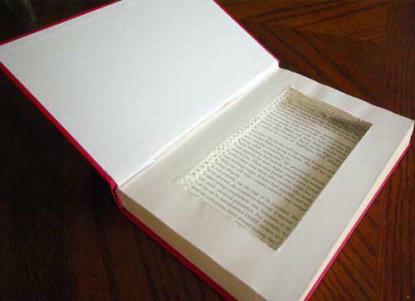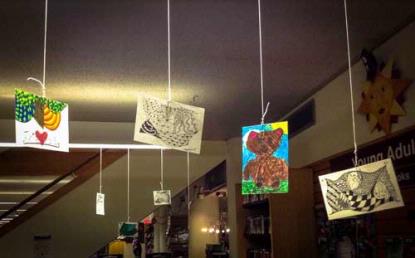On a recent Saturday, a group of adults and preteens gathered at the J.V. Fletcher Library in Westford, MA and began cutting up books. I mean, really tearing into them, leaving big holes in the pages. Right there in plain view of the librarian.
And no one stopped them.
They cut and ripped and cut some more.
And then something magical happened.
The books were reborn.
They became art.
I saw it all. I was the lucky soul invited to facilitate this fall’s Mass Humanities Family Adventures in Reading (FAIR) for Preteens program at the library. The intent of the program is simple: bring preteens and their adult caregivers together to talk about books and make art. Though the program is only in a pilot phase (it’s an offshoot of an existing FAIR program for younger readers), it’s already produced a host of unexpected delights. Over a period of two months, we met four times to talk about Wonderstruck, by Brian Selznick and Wonder, by R.J. Palacio. In case you’re wondering, the word “wonder” had nothing to do with book choice, but reader insight did: Kira McGann, the young adult librarian in Westford, knew exactly what her community read and what they weren’t likely to read. Content played a role as well – we chose books that weren’t obviously oriented toward girl or boy readers.
Unexpected delight #1: Who showed up. Based on participation in the library’s other book groups, we assumed girls would sign up, and their moms, too. As it turned out, we saw a stronger showing of dads, which made me wonder if something about the program appealed to them specifically. Was it the book selection? The artmaking? Our group included four dads, two moms, one boy, and four girls; in some sessions, parents came together. When asked why they’d signed up for FAIR, participants described themselves as avid readers and said they were drawn to the opportunity to share a reading (and artmaking) experience together.
Unexpected delight #2: Big love for print (still). Our group – the preteens in particular – were vocal about how they loved the feel, smell, and weight of a book in their hands, and that they preferred to read and learn on paper versus the screen. E-books are here to stay, but there is an experiential difference between printed content and electronic content. If this group of preteens is any indicator, printed books have a secure place in the future.
Remember the book-cutting incident? We were turning the books into treasure boxes. There was a moment when I held up my craft knife and asked, “Should we be doing this? Is it OK to destroy a book?” The group dug deeper into their texts and debated. It’s wrong; this is someone’s hard work, one person said. Another said: but no one wants these books, so we’re recycling, giving them another life. Collectively we wondered what makes a book worth saving and sharing, especially in the age of e-books, when another copy is a click away. In another session, we watched a book trailer for Wonder, which the group found unsettling. Those brief minutes of visual content challenged their view of the characters, and they preferred the characters they’d built in their heads to what they saw on screen.

Unexpected delight #3: Magic happens when you blend artmaking and book talk. Each session incorporated an art-making project – a handmade journal, a treasure box, a self-portrait collage, postcard art – and we found the conversation flowed easiest while we were creating. In our last session, while we worked on postcard art, conversation became effortless between adults and preteens, and we were on to some hard themes:
- Bullying. Several of the preteens had experienced bullying or witnessed it among their peers, while parents talked about the anxiety and fear of having your own child seen as a bully.
- The nature of compassion. On this point, I asked the preteens what they would say to Julian, the bully in Wonder, if he sat down at our table that day. Would they shun him, or treat him as he’d treated others in the book? They answered with curiosity and great compassion. It nearly silenced the adults in the room. One preteen said she’d just ask him why he’d acted mean. Another said, “I wouldn’t ask him anything at all. I’d want to get to know him first.”
There’s something about the act of creating art that invites easy, open conversation, even on tough subjects. We become open to possibilities, not only to the art we’re creating, but to the possibility found in another person’s ideas and perspective. It bonds us. That’s the power in a program like FAIR for Preteens: it nurtures family bonds during those precious metamorphic years when children are, as middle-grade novelist Jeanne Birdsall aptly wrote, “moving toward an identity apart from their families but haven’t yet submerged themselves in peer groups.” For many families, it’s a process of pulling away and coming back together, over and over; it can take your breath away.
That last Saturday, we could’ve kept on talking. But the sun was setting and the library was closing. Time was up, but we were just getting started, really. And wasn’t that the point after all, to keep on talking?
Photos:
Top: Box of Wonder. In session #2, inspired by Wonderstruck’s cabinet of wonders, we cut out the centers of the books and transformed them into treasure boxes. Photo by C. Regan Davi.
Bottom: The Great Postcard Art Show. In session #4, inspired by Wonder’s postcard precepts, we created zentangle art and drawings on postcards that are now hanging as an exhibition in the library. Each postcard includes a precept on the backside. When the exhibition comes down, each participant will get another’s postcard art and precept in the mail. Photo by Kira McGann.


